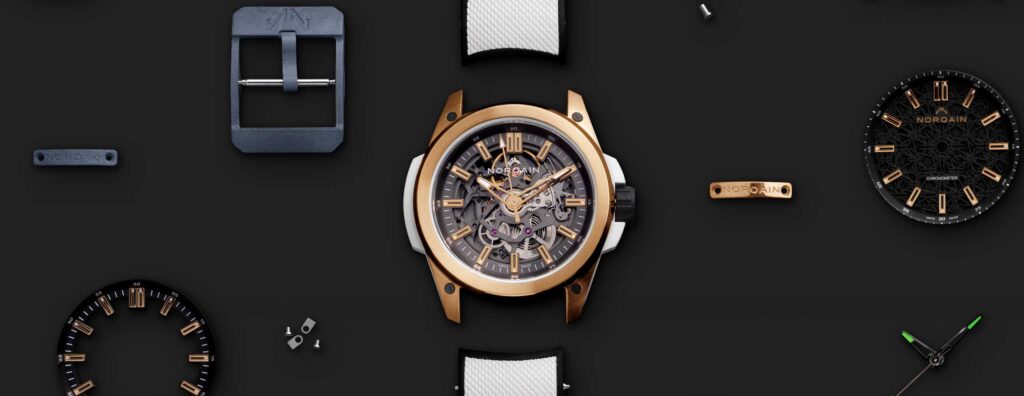Feature
Exploring Time: Carl F. Bucherer harnesses the ingenuity of peripheral technology to present a dynamic vision of contemporary watchmaking
Feature
Exploring Time: Carl F. Bucherer harnesses the ingenuity of peripheral technology to present a dynamic vision of contemporary watchmaking
In a world where everyone jostles to be at the center of attention, Carl F. Bucherer has found a unique position by focusing on the periphery. The Lucerne based manufacture is known for many things, but above all it is regarded as the leader in peripheral technology with not one, not two but three different applications of this ingenious mechanism. It is the first brand to produce a peripheral rotor automatic movement in series which is a remarkable achievement for a rather young manufacture, and thus has drawn inspiration from this incredible endeavor to scale ever greater heights.
To be clear, Carl F. Bucherer did not invent the concept of peripheral automatic winding — that was done in 1955 by a Swiss watchmaker named Paul Gosteli. Instead, what Carl F. Bucherer had done was to devise a way to make the invention available in large volumes and still perform reliably, which is just as, if not more, significant a contribution. Until 2008, when Carl F. Bucherer launched the caliber CFB A1000, peripheral automatic winding movements were a rarity largely because of reliability issues. The Caliber CFB A1000 took Carl F. Bucherer three years to develop

Carl F. Bucherer introduced CFB A2000 in 2016
So across the entire historical timeline of peripherical automatic winding, there are only two names that have made real impact on this style of movement design. The first was of course Gosteli for having invented it, and the second was undoubtedly, unequivocally and unmistakably Carl F. Bucherer because no one else comes close. And just as the manufacture played a pivotal role in shaping the evolution of peripheral automatic winding, so did this mechanical system help establish a dynamic vision of modern watchmaking for Carl F. Bucherer.
The Automatic Peripheral System
Beginning with caliber CFB A1000, which is a huge technical achievement by any and all measure, Carl F. Bucherer’s horological identity swiftly took form. The manufacture recognized very early on that in the new millennium, watches are not acquired for the sake of utility and precision but emotion and appreciation. To encounter a timepiece, admire its aesthetics, and then turn it around to discover the inner mechanics is a ritual that watch enthusiasts never tire of.

Assembly of the CFB A1000 movement
Which was why the notion of a peripheral automatic winding movement reverberated so naturally with the times. It offers the convenience of a self-winding caliber while allowing us to admire the movement in its full glory, since the oscillator is around the circumference, rather than above the movement. It also matches the winding efficiency of a full-sized rotor as opposed to a micro-rotor, with the bonus of an overall thinner movement. Carl F. Bucherer uses tungsten rather than gold or platinum for its oscillator, emphasizing performance and technicity in its choice of material.
Carl F. Bucherer debuted a number of new improvements to bring caliber CFB A1000 to completion. It used a peripherally-mounted annular segment geared by diamond-like carbon (DLC) glides with ceramic ball bearings mounted on spring-retained rockers. It also has the Triple Dynamic Shock Absorption System protecting the rotor from impact.

Carl F. Bucherer CFB A2000
Following caliber CFB A1000 came the updated caliber CFB A2000 in 2016, which serves as the manufacture’s go-to movement of choice for its current timepiece collections especially in the Manero line. The Manero Peripheral for instance is an excellent daily watch at 40.6mm with a wide selection of colors and strap or bracelet options, yet all of which offers the same stunning view as soon as you turn the watch over. In this watch, caliber CFB A2050 greets the eye, and you’d think it were suspended in mid-air if not for the ring in silver and dark grey that swivels freely around which is the namesake peripheral winding rotor.
The Manero Tourbillon Double Peripheral
Seemingly inspired by this exhilarating sight, Carl F. Bucherer pushed further in this direction and incorporated within its first in-house manufactured tourbillon the same idea of a mechanical object suspended in mid-air. And just as its peripheral winding rotor is neither a traditional oscillating weight nor a micro-rotor, its Floating Tourbillon is neither a traditional bridged tourbillon nor a flying tourbillon. For it is neither mounted on the movement main plate nor an overlying bridge.

Carl F. Bucherer CFB T3000 tourbillon double peripheral
Instead, it uses a peripherally mounted rotating carriage supported at three points by ceramic ball bearings that also guide the bearing wheel at its circumference. As with the use of a peripheral winding rotor, the Floating Tourbillon construction allows for a thinner overall movement, plus an unhindered view of the rotating carriage from BOTH sides.

Components of the CFB T3000 movement including the tourbillon with silicon escapement
And caliber CFB T3000 is precisely the sort of tourbillon you would want to admire up close with complete clarity. Positioned at 12 o’clock, it is a COSC-certified tourbillon with stop-seconds function. The carriage is stunning to look at, minimalist in design and finished with matte sandblasted surfaces for a cool, industrial-age look which juxtaposes beautifully with the polished gold-tone balance wheel, index and gear wheel. Most fascinatingly, the entire escapement including the pallet and escape wheel is made of silicon, which once again affirms the progressive watchmaking philosophy of Carl F. Bucherer.

Carl F. Bucherer's Floating Tourbillon with silicon escapement to minimise inertia. The cage itself consists of a toothed wheel that is driven by a wheel on its periphery
Using as well a peripheral winding rotor, caliber CFB T3000 powers the Manero Tourbillon Double Peripheral which is designed in a range of case materials and dial options, including a very exuberant rainbow gem-set model, the Manero Tourbillon Double Peripheral Paradise with baguette-cut sapphires.
The Manero Minute Repeater Triple Peripheral
After realizing its own vision of a modern tourbillon, Carl F. Bucherer sought to challenge itself further in the realm of high complications, and very quickly the ambition to make its own chiming watch dominated the conversation. This year we have witnessed the introduction of the Carl F. Bucherer Manero Minute Repeater and if you have been paying attention to the story, you will know that, one, this is no ordinary minute repeater and two, it will definitely have incorporated the manufacture’s patented peripheral technology, which is by now a signature of Carl F. Bucherer.

Carl F. Bucherer CFB MR3000 with the unique triple peripheral technology
The movement within is of course developed entirely in-house. Caliber CFB MR3000 is based on the Floating Tourbillon CFB T3000 so it shares with it key features such as the peripheral automatic winding system and the peripherally mounted tourbillon regulator. In addition, it introduced yet another world-first by Carl F. Bucherer: a minute repeater with a peripherally mounted fly governor. And by doing so, the manufacture achieved one of the hardest grand complications to produce while incorporating an essential mechanism that is completely unique to its DNA.

The Manero Minute Repeater highlights its peripheral fly regulator on the dial
The minute repeater as we all know is a complex mechanical system comprising a series of racks and cams controlling a pair of hammers that strike onto metal gongs in order to chime the time in hours, quarters and minutes. It is an invention that goes all the way back to the 18th century, and yet Carl F. Bucherer has managed to inject a clear sense of modernity in its first attempt at this high complication. To regulate the speed of its chimes such that the movement emits a melodious symphony of time, the manufacture utilizes a mounted peripherally just like its tourbillon and the oscillating weight.

The Manero Minute Repeater 30th Anniversary with blue baguette-cut sapphires
As such this essential device which never usually gets the spotlight takes center stage in the caliber CFB MR3000 and can be seen on the dial side through a circular aperture at six o’clock flanked by the two hammers. Regulators are usually fitted onto the last wheel in the governor train, but here it is mounted via three low-friction ceramic ball bearings, it spins into action every time the repeater is activated. Its curved arms skew outwards, controlled by two tiny springs, assuring perfect silence whenever the chimes are in play.
This three-part journey to establishing its own identity in modern watchmaking has very ably demonstrated Carl F. Bucherer’s unique vision and strong manufacturing capabilities. And more is certain to come from the brand. Its CTO Samir Merdanovic emphasizes the importance of the achievements in peripheral technology to the brand: “Clearly, our accomplishments in peripheral technology have become our flagship. When we secured our patent on the peripheral winding system back in 2008, it sparked the passion that ultimately led to the creation of this new watch. We are proud of what we’ve achieved and excited about sharing it with the world.”











